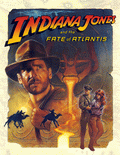
































Indiana Jones and the Fate of Atlantis

Indiana Jones and the Fate of Atlantis is a point-and-click adventure game by LucasArts originally released in 1992. Almost a year later, it was reissued on CD-ROM as an enhanced 'talkie' edition with full voice acting and digitized sound effects. In 2009, this version was also released as an unlockable extra of the Wii action game Indiana Jones and the Staff of Kings, and as a digitally distributed Steam title.
The plot is set in the fictional Indiana Jones universe and revolves around the eponymous protagonist's global search for the legendary sunken city of Atlantis. Sophia Hapgood, an old co-worker of Indiana Jones who gave up her archaeological career to become a psychic, supports him along the journey. The two partners are pursued by the Nazis who seek to use the power of Atlantis for warfare, and serve as the adventure's antagonists. The story was written by Hal Barwood and Noah Falstein, the game's designers, who had rejected the original plan to base it on an unused movie script. They came up with the final concept while researching real-world sources for a suitable plot device.
Fate of Atlantis was praised by critics and received several awards for best adventure game of the year. It became a million-unit seller and is widely regarded as a classic of its genre today. Two concepts for a supposed sequel were conceived, but both projects were eventually canceled due to unforeseen problems during development. They were later reworked into two separate Dark Horse Comics series by Lee Marrs and Elaine Lee, respectively.
The story of Fate of Atlantis is set in 1939, on the eve of World War II. At the request of a visitor named Mr. Smith, archaeology professor and adventurer Indiana Jones tries to find a small statue in the archives of his workplace Barnett College. After Indiana retrieves the horned figurine, Smith uses a key to open it, revealing a sparkling metal bead inside. Smith then pulls out a gun and escapes with the two artifacts, but he loses his coat in the process. The identity card inside reveals 'Smith' to be Klaus Kerner, an agent of the Third Reich. Another pocket of the coat holds an old magazine containing an article about an expedition on which Indiana collaborated with Sophia Hapgood, who has since given up archeology to become a psychic. Fearing that she might be Kerner's next target, Indiana travels to New York in order to warn her and to find out more about the mysterious statue.
Fate of Atlantis is based on the SCUMM story system by Ron Gilbert, Aric Wilmunder, Brad P. Taylor, and Vince Lee, thus employing similar gameplay to other point-and-click adventures developed by LucasArts in the 1980s and 1990s. The player explores the game's static environments while interacting with sprite-based characters and objects; they may use the pointer to construct and give commands with a number of predetermined verbs such as 'Pick up', 'Use' and 'Talk to'. Conversations with non-playable characters unfold in a series of selectable questions and answers.
Early on, the player is given the choice between three different game modes, each with unique cutscenes, puzzles to solve and locations to visit: the Team Path, the Wits Path, and the Fists Path. In the Team Path, protagonist Indiana Jones is joined by his partner Sophia Hapgood who will provide support throughout the game. The Wits Path features an abundance of complex puzzles, while the Fists Path focuses heavily on action sequences and fist fighting, the latter of which is completely optional in the other two modes. Atypical for LucasArts titles, it is possible for the player character to die at certain points in the game, though dangerous situations were designed to be easily recognizable. A score system, the Indy Quotient Points, keeps track of the puzzles solved, the obstacles overcome and the important objects found.
How to play:
Click on the joystick icon in the Indiana Jones and the Fate of Atlantis online emulator to see how to control the Indiana Jones and the Fate of Atlantis game









































Comments